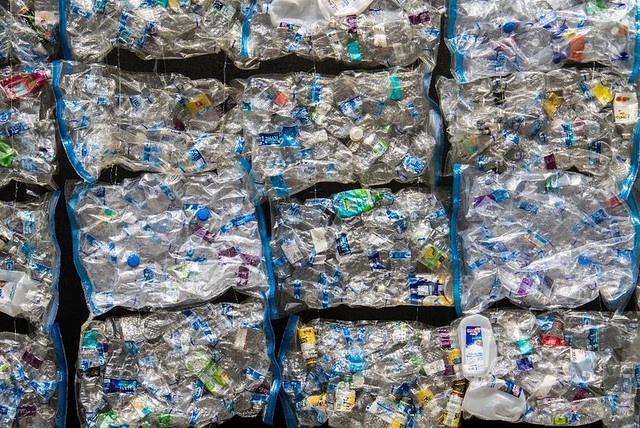
Guest Writer HOW IT WORKS
bioremediation bacteria plastic pollution environment
Bacteria: The Solution to Our Plastic Waste Problem?
Plastic is cheap and sturdy, which is why it’s incredibly useful and widely used [1]. It’s hard to think of a part of your daily routine that doesn’t involve plastic products in some way. However, the durability of plastic is a double edged sword that makes plastic waste removal a persistent challenge. There are between 60 and 99 million metric tons of plastic currently in the environment, and that number is only increasing [1]. Every year, at least 8 million tons of plastic end up in our oceans, where they cause significant damage to marine animals that mistakenly consume or become entangled in our trash [2-3]. And due to its aforementioned sturdiness, this plastic isn’t going anywhere. In the ocean the half-life of plastic can be up to 1,200 years, depending on the type of plastic [4].

Figure 1. Plastic waste in a river, which will likely end up in the ocean. Source: Unsplash, Alexander Schimmeck.
Clearly, we need to find some way to deal with the massive amount of plastic in our environment. Some scientists are looking to nature for solutions. Certain organisms are able to degrade plastic, including fungi, algae, and bacteria, among others [5]. Bacteria found in the gut of earthworms were able to degrade 60% of a certain type of microplastic in a mere 3 weeks [6]! However, most of these plastic-degrading species cannot survive on plastic alone. Mealworms are able to break down plastic, but when plastic is the only available energy source, they starve to death or resort to eating their deceased mealworm companions [7]. The obvious solution would be to supply mealworms with an extra food supply, but this would be so costly that it’s not a viable solution [7].
Of all the candidate organisms there’s one species that seems particularly promising: a bacteria called Ideonella sakaiensis. Originally isolated from soil in a plastic waste dump site, I. sakaiensis is special because it doesn’t just happen to degrade plastic – plastic is its primary source of energy and carbon [8]. I. sakaiensis has a special, one-of-a-kind enzyme called a PETase that breaks down a common type of plastic called polyethylene terephthalate (PET) into smaller compounds, which are then turned into energy [3]. Given the abundance of plastic in the environment, plastic-eating bacteria have a survival advantage – they have plenty of plastic “food” to consume.
While I. sakaiensis is clearly promising, research into how we can use this bacterium is ongoing. One major benefit of I. sakaiensis is that it doesn’t require a special bioreactor or additional energy to degrade plastic, which makes applications involving this bacterium more practical and economically feasible [3]. However, challenges still remain. For example, I. sakaiensis is unable to grow well on a certain type of PET, meaning that if you dropped a plastic water bottle into a vat of these bacteria, only about half of the water bottle could be degraded in its current state [9].
Biotechnology offers solutions to these problems and ways to improve on nature’s plastic-degrading design. For example, the gene for I. sakaiensis’s special PETase could be placed in another type of bacteria that can grow better on a plastic surface. The gene for a different plastic-degrading enzyme has already been inserted into E. coli, giving it the ability to degrade plastic [10]. Similar technology could be used on I. sakaiensis. Researchers have also created slightly altered versions of the PETase gene that are better able to degrade PET, which could be used for increased efficiency [11].

Figure 2. A wall in Singapore made of plastic waste. Source: Unsplash, Nick Fewings.
Even if this bioremediation process is perfected, we still don’t know if people will be willing to buy or use this technology. Would you be willing to have a vat of plastic-eating bacteria in your backyard to break down your plastic waste? What about in your town’s waste management center? Bacteria would need a serious PR campaign before this promising solution could be integrated into daily life, but it would be worth the effort if it means saving the environment and protecting the lives of the billions of species on our planet.
References
[1] T. Stanton et al., “It’s the product not the polymer: Rethinking plastic pollution,” WIREs Water, vol. 8, no. 1, p. e1490, 2021, doi: https://doi.org/10.1002/wat2.1490.
[2] A. L. Andrady, “Microplastics in the marine environment,” Marine Pollution Bulletin, vol. 62, no. 8, pp. 1596–1605, Aug. 2011, doi: 10.1016/j.marpolbul.2011.05.030.
[3] I. Taniguchi, S. Yoshida, K. Hiraga, K. Miyamoto, Y. Kimura, and K. Oda, “Biodegradation of PET: Current Status and Application Aspects,” ACS Catal., vol. 9, no. 5, pp. 4089–4105, May 2019, doi: 10.1021/acscatal.8b05171.
[4] A. Chamas et al., “Degradation Rates of Plastics in the Environment,” ACS Sustainable Chem. Eng., vol. 8, no. 9, pp. 3494–3511, Mar. 2020, doi: 10.1021/acssuschemeng.9b06635.
[5] A. Amobonye, P. Bhagwat, S. Singh, and S. Pillai, “Plastic biodegradation: Frontline microbes and their enzymes,” Science of The Total Environment, vol. 759, p. 143536, Mar. 2021, doi: 10.1016/j.scitotenv.2020.143536.
[6] E. Huerta Lwanga et al., “Decay of low-density polyethylene by bacteria extracted from earthworm’s guts: A potential for soil restoration,” Science of The Total Environment, vol. 624, pp. 753–757, May 2018, doi: 10.1016/j.scitotenv.2017.12.144.
[7] P. Billen, L. Khalifa, F. Van Gerven, S. Tavernier, and S. Spatari, “Technological application potential of polyethylene and polystyrene biodegradation by macro-organisms such as mealworms and wax moth larvae,” Science of The Total Environment, vol. 735, p. 139521, Sep. 2020, doi: 10.1016/j.scitotenv.2020.139521.
[8] S. Yoshida et al., “A bacterium that degrades and assimilates poly(ethylene terephthalate),” Science, vol. 351, no. 6278, pp. 1196–1199, Mar. 2016, doi: 10.1126/science.aad6359.
[9] N. E. Wallace, M. C. Adams, A. C. Chafin, D. D. Jones, C. L. Tsui, and T. D. Gruber, “The highly crystalline PET found in plastic water bottles does not support the growth of the PETase-producing bacterium Ideonella sakaiensis,” Environmental Microbiology Reports, vol. 12, no. 5, pp. 578–582, 2020, doi: https://doi.org/10.1111/1758-2229.12878.
[10] M. Gyung Yoon, H. Jeong Jeon, and M. Nam Kim, “Biodegradation of Polyethylene by a Soil Bacterium and AlkB Cloned Recombinant Cell,” J Bioremed Biodegrad, vol. 03, no. 04, 2012, doi: 10.4172/2155-6199.1000145.
[11] C. Liu, C. Shi, S. Zhu, R. Wei, and C.-C. Yin, “Structural and functional characterization of polyethylene terephthalate hydrolase from Ideonella sakaiensis,” Biochemical and Biophysical Research Communications, vol. 508, no. 1, pp. 289–294, Jan. 2019, doi: 10.1016/j.bbrc.2018.11.148.
More From Thats Life [Science]
- CRISPR technology may be a promising tool to combat multidrug resistant fungus C. auris
- How the search for a universal gene forever changed biology: the story of Carl Woese and 16S sequencing
- Quarantine Blues? The Effects of Social Isolation in the Brain
- The Lovebug Effect
- CRISPR: Careful When Running with Genetic Scissors
- More ›
